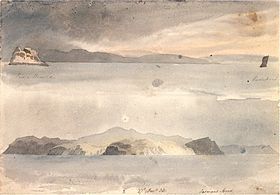Pedra Branca (Tasmania)

An artist's impression of Pedra Branca and Eddystone, 1823.
|
|
| Etymology | Portuguese: "white rock" |
|---|---|
| Geography | |
| Location | Southern Ocean |
| Coordinates | 43°51′00″S 146°58′12″E / 43.85000°S 146.97000°ECoordinates: 43°51′00″S 146°58′12″E / 43.85000°S 146.97000°E |
| Area | 2.5 ha (6.2 acres) |
| Length | 270 m (890 ft) |
| Width | 100 m (300 ft) |
| Highest elevation | 60 m (200 ft) |
| Administration | |
|
Australia
|
|
| State | Tasmania |
| Region | Southern |
| Demographics | |
| Population | 0 |
Pedra Branca is a rock islet or small island, located in the Southern Ocean, off the southern coast of Tasmania, Australia. The island is situated approximately 26 kilometres (16 mi) south southeast of South East Cape and is contained within the Southwest National Park, part of the Tasmanian Wilderness World Heritage Site. An erosional remnant of the Tasmanian mainland, the island is approximately 270 metres (890 ft) long, 100 metres (330 ft) wide, with an elevation of 60 metres (200 ft) above sea level. The island is estimated to have separated from the Tasmanian mainland at least 15,000 years ago.
Pedra Branca is known for its inaccessibility, rich marine wildlife, wet and windy weather, interesting geology and large waves. With an area of 2.5 hectares (6.2 acres), the island is small enough to provide an example of an outcrop that lies on the border between being a rock or islet and an island. The geology features three breccia cones of dolerite and sandstone.
The only plant species found on the island is the succulent Sarcocornia quinqueflora. Recorded breeding seabird species include fairy prion, Pacific gull, silver gull, kelp gull, black-faced cormorant, Australasian gannet, and shy albatross.Australian fur seals use the island as a regular haul-out site while New Zealand fur seals visit occasionally.
...
Wikipedia

